Radioactive Fallout from Nuclear Weapons Tests
Total Fallout in the United States from nuclear weapons tests conducted during the period 1951-1970
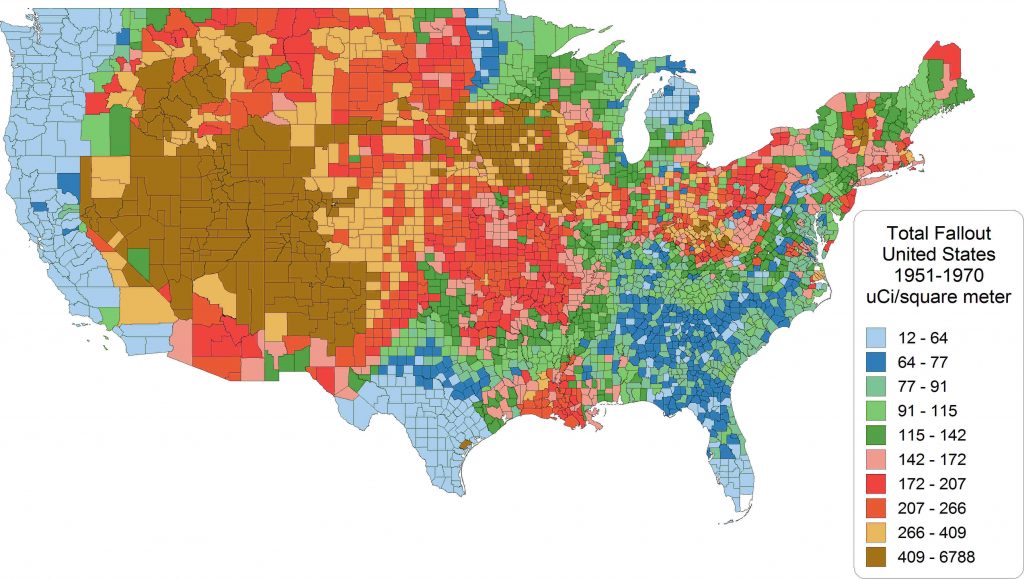
Creating an atmospheric nuclear detonation is an extremely efficient way to spread radioactivity throughout the globe. While most of the 200 or so radioactive isotopes (often called radionuclides) created in a nuclear detonation have very short half-lives (they self-destruct in a manner of seconds, hours, days or weeks), there are some long-lived radionuclides that remain in the environment for decades, centuries, millenia, and even millions of years.
Radioactive fallout was created by at least 566 atmospheric nuclear weapons tests, plus radioactivity was also created and sometimes released by another 1375 underground tests. Such releases were particularly “dirty”, that is, they were highly radioactive.
United States: 1,054 total tests, including 216 atmospheric tests, most at Nevada Test Site and the Pacific Proving Grounds in the Marshall Islands, with 10 other tests taking place at locations in including Amchitka Alaska, Colorado, Mississippi, and New Mexico.
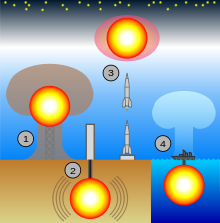
Four major types of nuclear testing:
1. atmospheric, 2. underground, 3. exoatmospheric, and 4. underwater
USA: 1,054 total tests; including 216 atmospheric tests, 100 occurring in Nevada
USSR : 715 total tests; 221 atmospheric tests conducted at Kazakhstan and the Kola Peninsula.
France: 210 total tests, 58 atmospheric tests, in Algeria (17) and French Polynesia (South Pacific)
Britain: 45 total tests, 45 atmospheric tests, 36 in Australia, 9 in Micronesia.
China: 45 total tests, 23 atmospheric tests, in Mongolia
India: 3 total (underground)
Pakistan: 2 total (underground)
North Korea: 3 total (underground)
note: Israel is said to have conducted a secret test in conjunction with South Africa in 1979
All the nuclear weapon tests took place in deserts or in oceans, where there was no flammable material, thus no nuclear firestorms were created and no global stratospheric smoke layer formed, i.e. no nuclear winter.
The fireballs of the large H-bomb (thermonuclear) tests from nuclear weapons, with explosive power of 200-kilotons or more, typically would rise above cloud level (the troposphere) into the stratosphere; the high winds in the stratosphere will then quickly blow the radioactive particles around (and encircle) the Earth. Eventually, over time, the long-lived radioisotopes like cesium137 and strontium90 (along with plutonium and uranium particles that had not been fissioned and were made into micro-particles) “fell out” of the stratosphere and were distributed over the entire world. One could not have designed a more efficient system to spread ionizing radiation over the entire planet.
Strontium90 (Sr90) is in the same atomic family as calcium, and acts as does calcium in the human body, where it is stored in the bones and teeth. Because strontium-90 does not exist in nature, it was quite identifiable as a product of nuclear fission that occurs in nuclear weapons (it is also made in nuclear reactors, but contained in the spent fuel unless released by accident). Studies of “baby teeth” showed that strontium-90 was accumulating in the teeth of children. This created a loud public outcry and put pressure on the leaders of the US and USSR to sign the Limited Test Ban Treaty (LTBT). Unfortunately, not all nuclear testing was banned, since the leaders of both nations wished to continue nuclear testing underground.
One year later, China detonated its first nuclear weapon in the atmosphere. So atmospheric testing did not end. The French also conducted many atmospheric nuclear weapons tests in the South Pacific. The environmental group, Greenpeace, sailed a ship (the Rainbow Warrior) into the French test zone and blocked a test. The French later blew up and sunk the Rainbow Warrior when it was in port in New Zealand; they were caught and eventually had to pay reparations to New Zealand. Eventually the French tests were stopped.
Fallout from atmospheric nuclear weapon tests in Nevada
Many thanks to physicist Richard Miller, who provided most of the images copied below. His website and many more images can be seen at http://www.260press.com/gallery-27.htm and http://www.260press.com/nuclear-fallout-maps.htm
Area crossed at least 2 times by Nevada nuclear test fallout
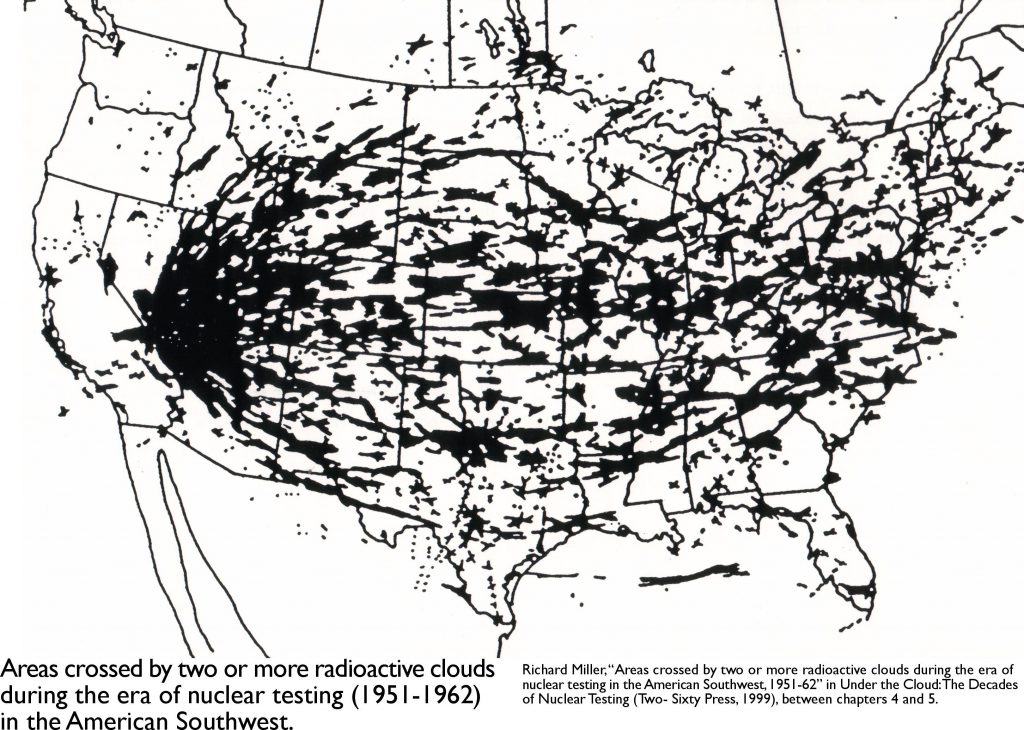
Fallout tends to concentrate in areas where it “rained out”, where the radioactive cloud became part of a weather system that caused it to be rained out onto the ground. Because the clouds traveled. The fallout also went into Canada and Mexico, too (just not pictured). The US also had fallout from Chinese and Russian nuclear weapons tests, the winds do not care about man-made borders.
The central mid-west states of Iowa and Missouri had a lot of radioactive cesium-137 fallout. Cesium-137 is water soluble and tends to widely disperse in ecosystems. Cs137 is in the same atomic family/group as potassium and this causes it to mimic potassium, and it is bioaccumulated in plants and animals along with potassium as a macronutrient. Because cesium-137 has a 30 year half-life (half of it will self-destruct every 30 years), about 25% of this cesium-137 is still in the Midwest soils, still going into all the grain grown there.
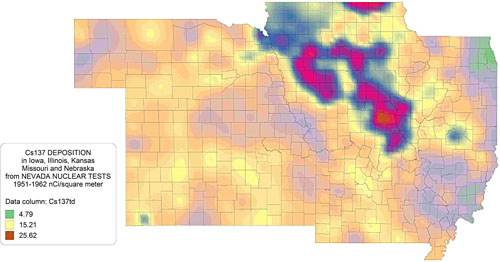
Cesium-137 deposition from cumulative effect of Nevada nuclear weapon tests
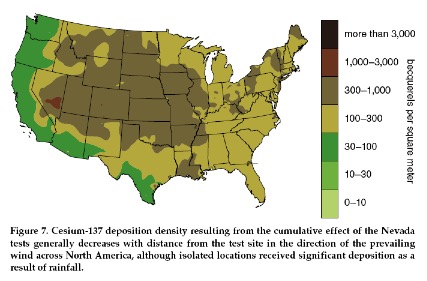
from https://www.cancer.gov/about-cancer/causes-prevention/risk/radiation/fallout-pdf
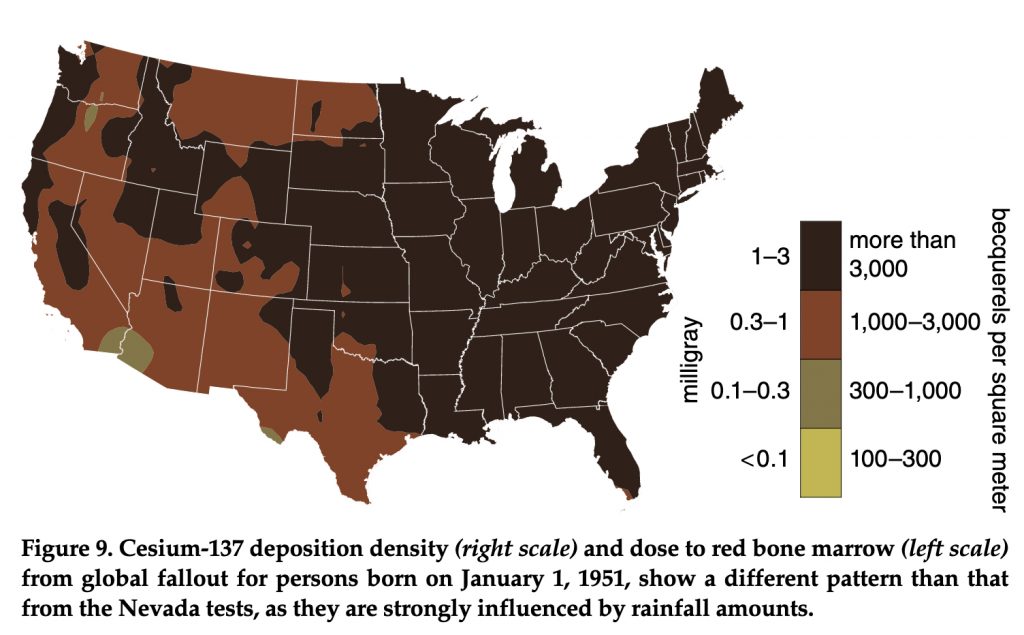
Data from NCI 1997 https://www.cancer.gov/about-cancer/causes-prevention/risk/radiation/Fallout-PDF
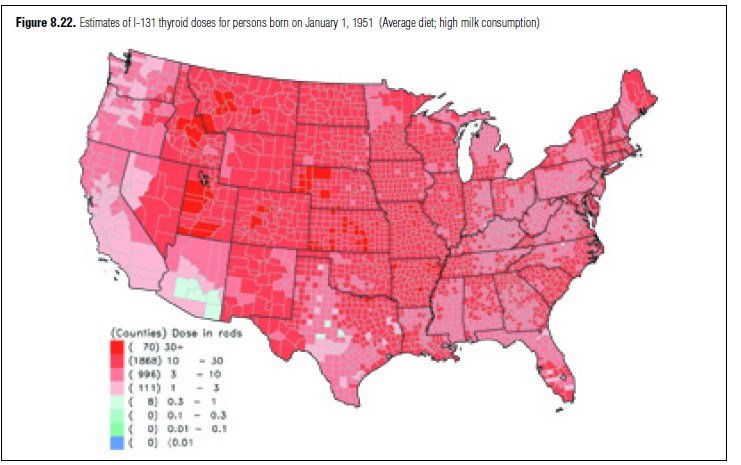
https://www.cancer.gov/about-cancer/causes-prevention/risk/radiation/i131-report-and-appendix
Many radioactive isotopes from the Nevada nuclear weapon tests fell on US, Canadian, and Mexican soils. Most had shorter half-lives, but they still emitted strong doses of ionizing radiation while they endured.
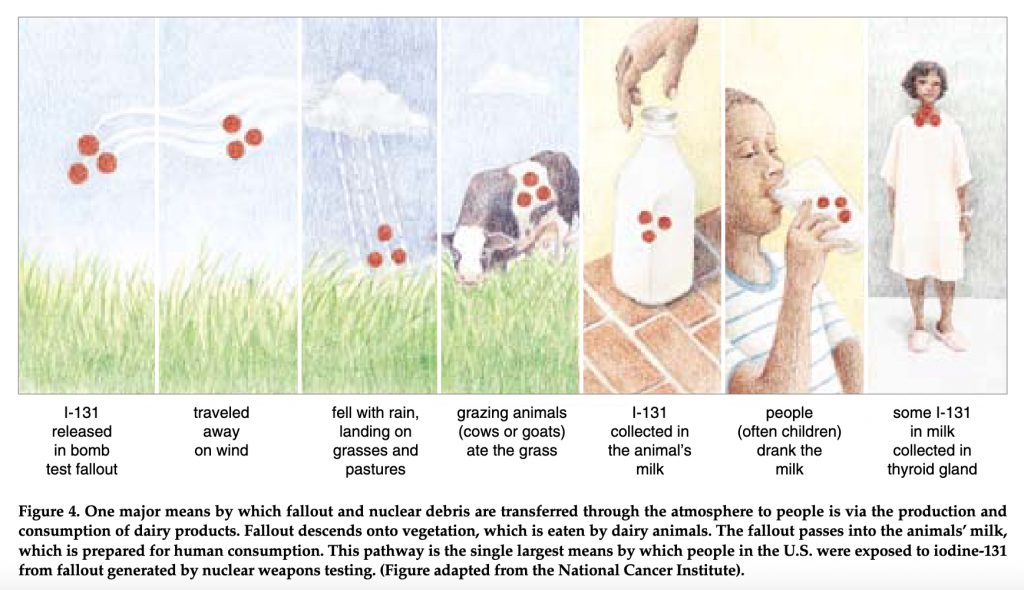
Rhodium-105 (half-life 35 hours) and Europium-155 (half-life 4.767 years) fallout from Nevada nuclear weapon tests
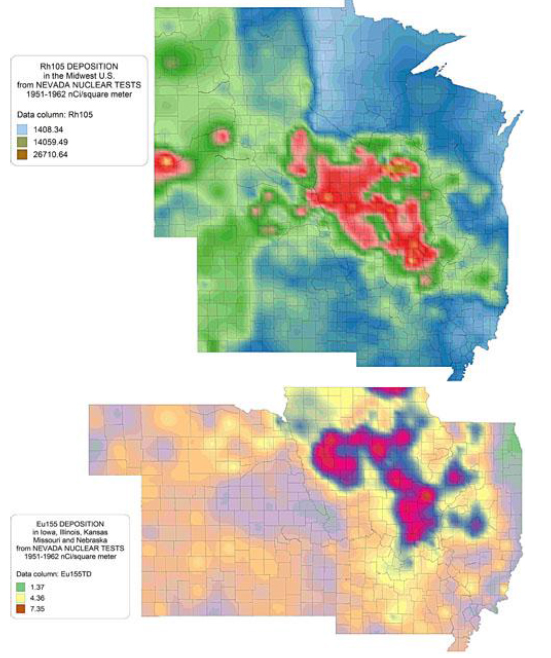
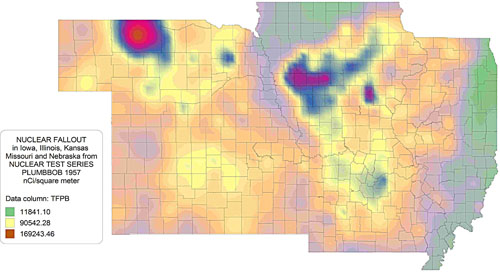
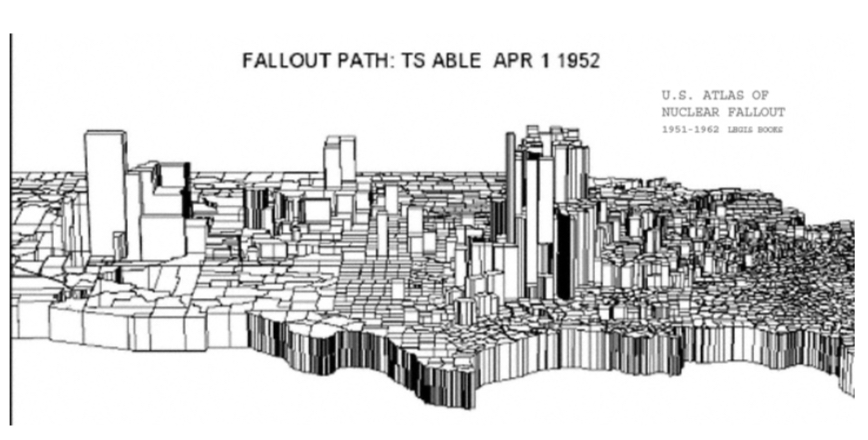
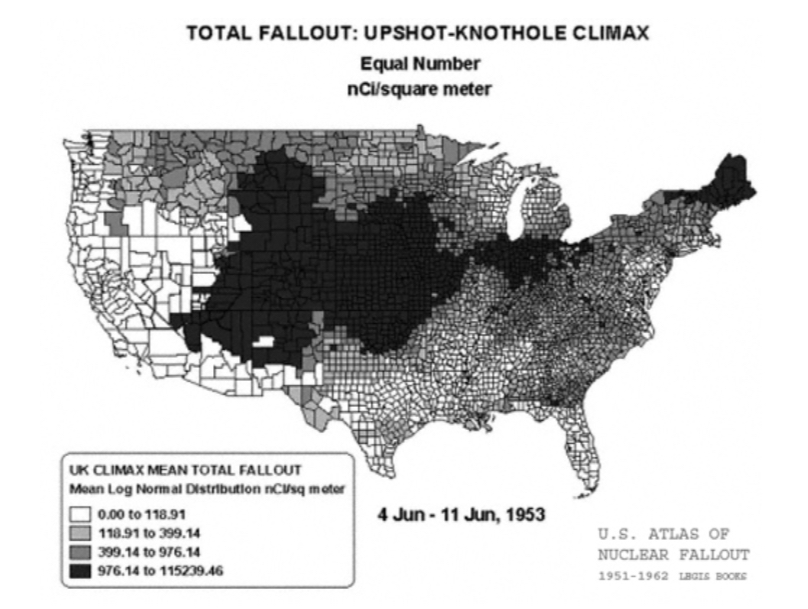
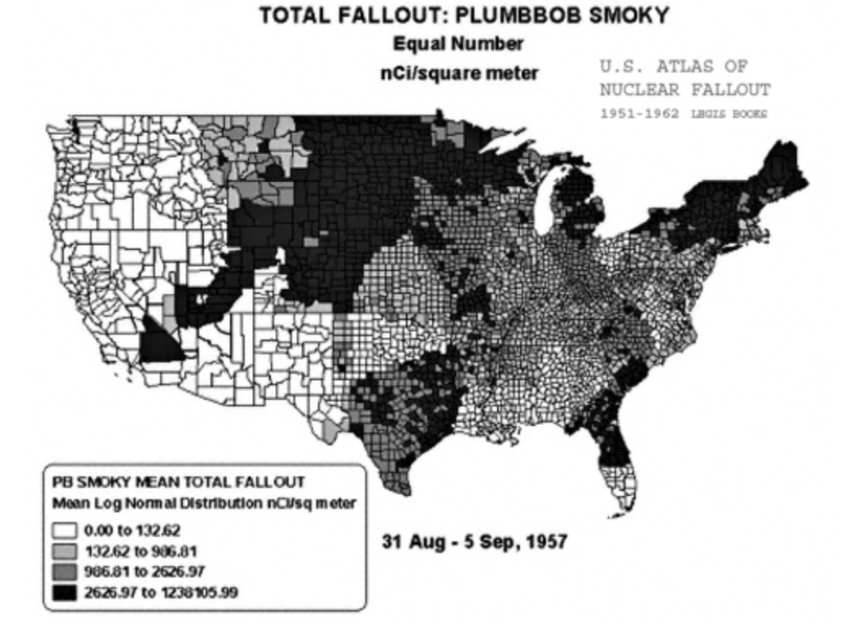
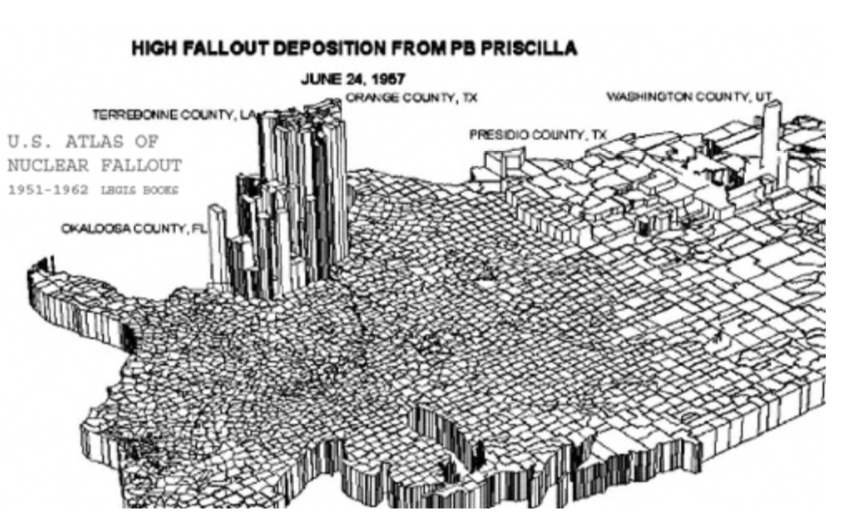
Consequences to human health
These articles provide great insight into the consequences of nuclear fallout (click the link to go to the article):
A Readiness to Harm: The Health Effects of Nuclear Weapons Complexes
The Brief Wondrous Life (and Long Dangerous Half-Life) of Strontium-90
The first major public health efforts aimed at banning nuclear testing were centered around the long-lived radionuclide strontium-90 (Sr90, half-life of 29 years), which was increasingly found in the baby teeth of children. The Missouri “Baby Tooth Survey” (1961-1970) was conducted, which led to widespread public concern and protest, pushing the leaders of the US and the USSR to sign The Limited Test Ban Treaty (LTBT, 1963).
Cesium-137 (Cs137), which has a long half-life (30 years), was also widely distributed by fallout from the atmospheric nuclear weapons tests. Cs137 is in the same atomic family/group as potassium and this causes it to mimic potassium, and it is selectively accumulated in plants and animals along with potassium as a macronutrient.
Cs-137 is water soluble and tends to widely disperse in ecosystems. Because cesium is a relatively rare element, usually occurs in soils at a rate of only 3 parts per million. Thus, plants do not discriminate between cesium and potassium, which is why they uptake cesium along with potassium. Cesium bioaccumulates in individual organisms and biomagnifies as it moves up the food chains.
In other words, cesium can build up in each organism that ingests or absorbs it. Therefore, it can become increasingly concentrated — bioconcentrated — in larger organisms/animals as they eat smaller organisms. This buildup is called biomagnification. Predators at the top of food chains can wind up with high concentrations of such industrial toxins like lead, arsenic, or radioactive fission products.
Studies in the last 20 years have shown that Cs-137 can cause a number of serious health problems, especially to children who routinely ingest contaminated foodstuffs. Studies of autopsied human tissues (done in Belarus) showed that Cs137 concentrates in vital human organs, in the endocrine glands, heart, pancreas, brain, stomach, and spleen.
Nuclear weapon test sites, and nuclear weapon manufacturing sites where accidents and careless disposal of nuclear materials and wastes routinely occur, led to increased sickness and death in exposed populations.
While the short-lived radionuclides self-destruct in the stratosphere, the long-lived radionuclides, such as cesium-137, strontium-90, and plutonium, “fallout” of the stratosphere for many years, creating global nuclear fallout.
Because the mushroom clouds of atmospheric nuclear weapon tests with yields of less than 100-200 kilotons stay below cloud level (in the troposphere), they can be rained out. Thus hundreds of nuclear tests led to massive contamination of states, regions, and continents, such as North America and Eurasia. Local populations in the region of test sites often severely impacted, including “downwinders” in Utah and Nevada, Kazakhstan, Mongolia, Australia, Micronesia, Algeria, and of course, where ever the wind blew the fallout and it rained out (see US fallout maps). However, often times regions hundreds of thousands of miles from the test sites were heavily contaminated. For example, an area in the state of New York was more heavily contaminated by fallout from one test than was the test site in Nevada. .
Plutonium has a half-life of 24,100 years. After 10 half-lives, 1/1000 of the original radioactive substance remains (divide 1 ten times in a row by 2). After 241,000 years, most plutonium will be gone. In other words, in human terms, it lasts forever.
15 millionths of 1 gram of plutonium will give you lung cancer if you inhale it. A few thousandths of a gram will kill you with pulmonary fibrosis.
Of course, there are many places in the world where nuclear testing occurred besides the US.
Massive amounts of plutonium and other radionuclides lie buried in a shallow grave barely above sea level in the South Pacific (high-level radioactive waste from US nuclear weapons tests). And the dome is corroding while the sea is rising.